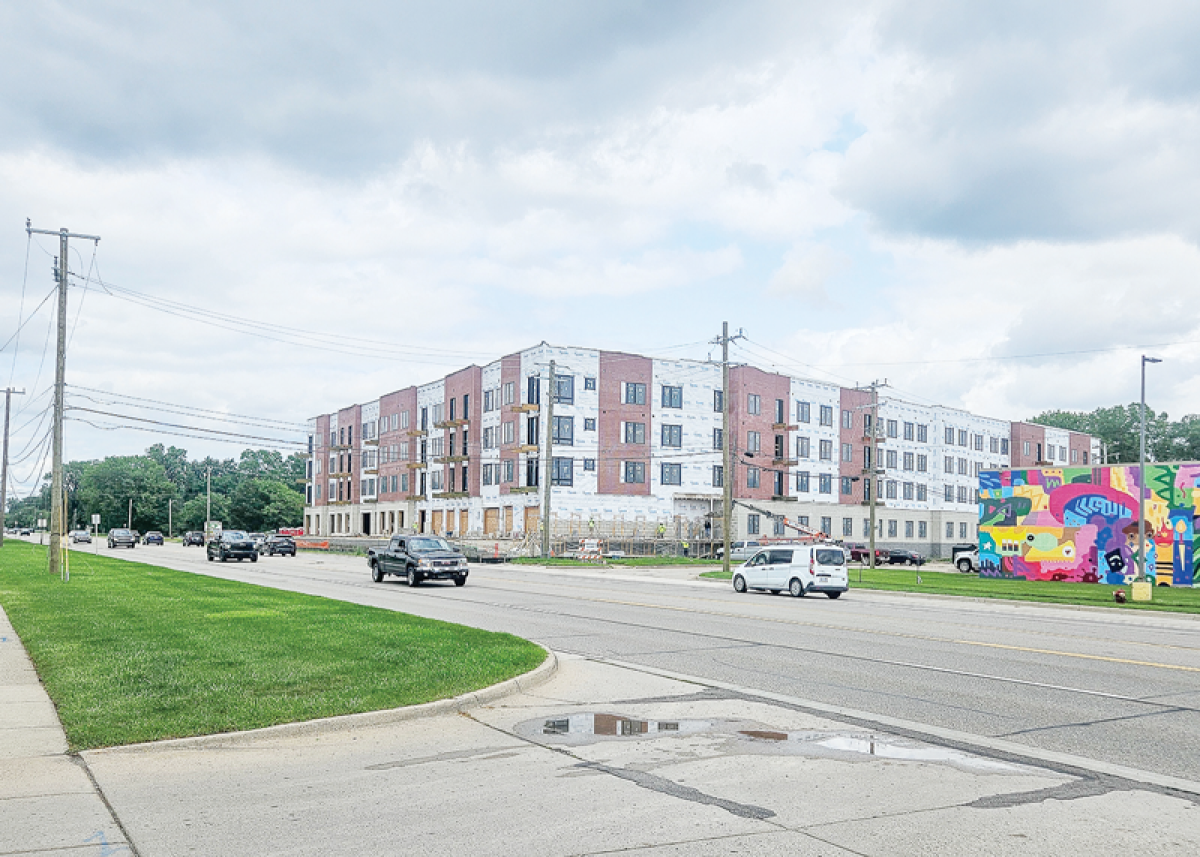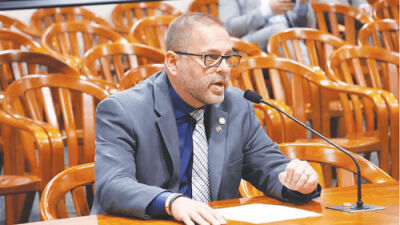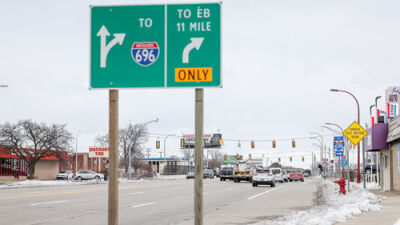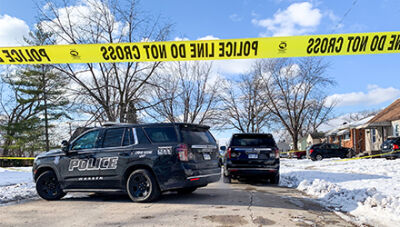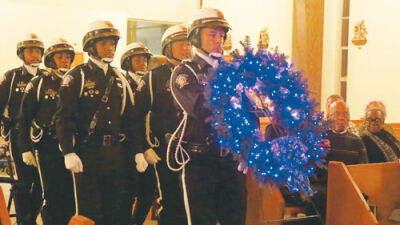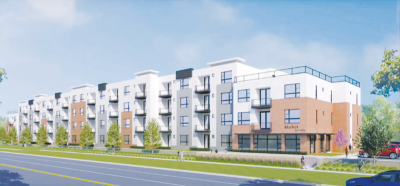
This rendering shows what the Chaldean Community Foundation’s “phase two” apartment proposal might look like.
Image provided by NF Engineers
STERLING HEIGHTS — A proposal that city officials say could add around 80 rent-controlled apartment units in the north Van Dyke Avenue corridor faced a temporary impasse due to a 3-3 tied Sterling Heights City Council vote at a July 16 meeting.
The vote was to consider the Chaldean Community Foundation’s proposal to build a mixed-use planned unit development on around 2 out of 10.34 acres of land at 43934 Van Dyke Ave.
The address, located on Van Dyke Avenue’s east side, north of Riverland Drive, used to be the site of the former Riverland Amusement Park, according to Sterling Heights senior economic adviser Luke Bonner. City officials say the property is in a floodplain area.
This is not the first time the CCF has planned apartments in the north Van Dyke corridor. The foundation already has a “phase one” four-story apartment complex under construction just a bit southward, and it expects that project to be complete in 2025. The latest proposed apartment project is considered phase two.
The city says it has acquired the 10.34 acres and closed on the purchase in early 2023 by spending around $640,000 in American Rescue Plan Act funds. As part of an associated purchase agreement, the city would sell a part of the land to the developer — CCF Development Grillo Limited Dividend Housing Association LLC — for around $60,000, or $30,000 per acre, Bonner said.
While the developer would at one point during the development process take liability for the entire 10.34 acres, it would eventually give the city around 8 acres back, Bonner said. The city could then keep that land as open or recreational space, or for trailway amenities, according to Sterling Heights City Planner Jake Parcell.
Parcell said the city’s Master Land Use Plan originally designated the property as office, park or open space, but he added that the city’s 2021 North Van Dyke Avenue sub-area plan says the land could be used for multifamily residences.
He also said the proposed apartment complex on that site would contain an estimated 80, possibly 82, one- or two-bedroom units, with each unit being around 750 to 900 square feet in size. Balconies or patio space would be incorporated into the design, and the building would also contain first-floor retail space, he said.
The apartments’ monthly rents are supposed to accommodate residents within 30%-80% of the area median income, Parcell said. According to CCF President Martin Manna, monthly rents will range from $795 to $1,100, and he explained that “this isn’t really Section 8.”
“What this is, more or less, is rent control,” Manna said. “So we will not be raising rents – (the Michigan State Housing Development Authority) doesn’t allow that. That’s part of the requirements of the loan. It’s only adjusted for the cost of inflation.”
In June, the Sterling Heights Planning Commission recommended the project’s approval 7-0, with two absences.
“This is really a very transformational plan to revitalize this corridor of the city,” Parcell added. “This area up here is a unique blend of industrial properties and retail ability that could stand for revitalization through new people in the area that can benefit from recreational amenities that will be there to reside within the city of Sterling Heights – live, work and play and shop in the city of Sterling Heights.”
During public comment, more than a dozen public speakers addressed the council on the topic, and they either shared concerns or opposition over the proposal, with most complaints dealing with potential flooding or traffic issues.
Some residents, including some who said they live near the proposed development, explained that they have seen unprecedented flooding on properties near the Clinton River, and some believed that apartment development only aggravates the situation.
“Currently, this land is absorbing water and slowing its release into the Clinton River,” resident Patricia Sutton said.
“The proposed development is going to seal that land with concrete impervious surfaces that will send storm runoff even more quickly into the Clinton River, overwhelming it and increasing the flood risk … to areas even further downstream like Riverland (Woods) Apartments, which already has a flooding problem.”
When the City Council deliberated, some members also weighed concerns over flooding and possible traffic increases.
Mayor Pro Tem Liz Sierawski said one reason she opposes the proposal is that it contradicts one of the objectives of the city’s November millage proposal, which is raising revenue to acquire and preserve open land in the city.
“This is what I see, is that we’re asking you (residents) to give us more money to maintain and to purchase more green space, and we’re selling off what green space we have,” Sierawski said. “So to me, that is not only a contradiction … it’s a dishonesty. And so I don’t feel that that is something that I can support.”
When council members asked City Engineer Brent Bashaw about whether new apartments could contribute to flooding in the area, he denied that and attributed the flooding to heavier rain events and environmental changes.
“We’re getting more heavy rain events than we’ve had in the past,” Bashaw said. “These 100-year rain events are happening every 10 years, it seems like now.”
Mayor Michael Taylor said he sympathizes with residents who have flooding issues, but noted that “the water is high everywhere” due to frequent rain.
“It’s not something that has to do with the Chaldean Community Foundation’s building,” Taylor said. “This is a phenomenon that’s happening throughout metro Detroit, and frankly, throughout the country that … weather is becoming more extreme and more extreme and more extreme. And that is the reality of it.”
Officials said the project would be reviewed by the Michigan State Housing Development Authority as well as the Michigan Department of Environment, Great Lakes and Energy.
Taylor said he trusts the experts and regulatory agencies to review the project and to only approve it if it abides by their guidelines. He praised the proposal for helping make housing more affordable, and he also didn’t believe that supporting the proposal is being hypocritical in terms of the November millage proposal’s intentions.
“It’s a 10-acre parcel, and 8 acres of it is going to be dedicated to public green space, which is exactly what the community has been saying they want,” Taylor said. “So to me, it’s an elegant compromise. It’s a compromise all across the board.”
When it was time to vote, Taylor, Councilman Michael Radtke and Councilwoman Barbara Ziarko voted yes. Sierawski and councilwomen Maria Schmidt and Deanna Koski voted no. Councilman Henry Yanez was absent.
According to Taylor, the issue should return to the council table Aug. 7. Should the “phase two” CCF apartment project be approved, the developers aim to start work in late 2025 and finish by late 2027, according to a timeline presented by city officials.
Learn more about the Chaldean Community Foundation by visiting chaldeanfoundation.org.
 Publication select ▼
Publication select ▼